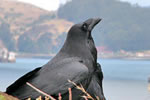Description |
The Peregrine Falcon is one of the world’s most magnificent birds of prey. At 18 inches in length, the Peregrine Falcon is the fastest bird on earth. Though it rarely exceeds speeds of 60 miles per hour, the Peregrine Falcon has been clocked at speeds of 200 miles per hour and faster. Highest speeds are reached during a stoop, when the falcon freefalls toward its prey from above. Prey is usually killed immediately from the impact. The adult Peregrine Falcon is blue-gray above and white below, with fine grayish streaks on the breast. It looks as if it has a blue-gray helmet on its head. Like all falcons, the Peregrine Falcon has long wings and a long tail. The feet are bright yellow. Females and males are similar, though the female is larger. |
Diet |
| Peregrine Falcons feed almost exclusively on birds caught in midair. Ducks, grouse, ptarmigan, shorebirds, and pheasants are often taken. In cities, Peregrine Falcons consume a large number of pigeons. |
Habitat |
| Peregrines breed in the Arctic Tundra, ocean cliffs, and skyscrapers of downtown areas. During migration and winter, Peregrine Falcons frequent seashores and wetlands. |
Range |
| Peregrine Falcons range throughout the world, and nest in all continents except Antarctica. In North America, it breeds throughout the Arctic, Canada, and the western United States. Small breeding populations have been reintroduced in the eastern United States. New York, Boston, Pittsburgh, and Baltimore are some urban areas that host nesting Peregrines. During fall migration, Peregrine Falcons can often be seen at hawk migration hotspots such as Hawk Mountain in Pennsylvania, or Cape May, New Jersey. Peregrine Falcons that nest in the arctic may migrate over 7,500 miles to their wintering grounds in southern South America. In a single year, such a bird may travel 15,000 miles! |
Status |
| Like many birds of prey, Peregrines Falcons have suffered from habitat destruction and DDT poisoning. Unlike other affected species such as Ospreys and Bald Eagles, Peregrine Falcons have been somewhat slower to recover. Nevertheless, their numbers have increased sufficiently to be considered for removal from the Federal Endangered Species list. |
 |
 |
 |
 |
 |
 |
 |
 |
 |
 |
 |
 |
 |
 |
 |